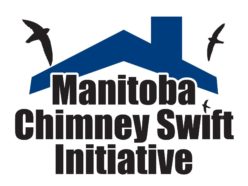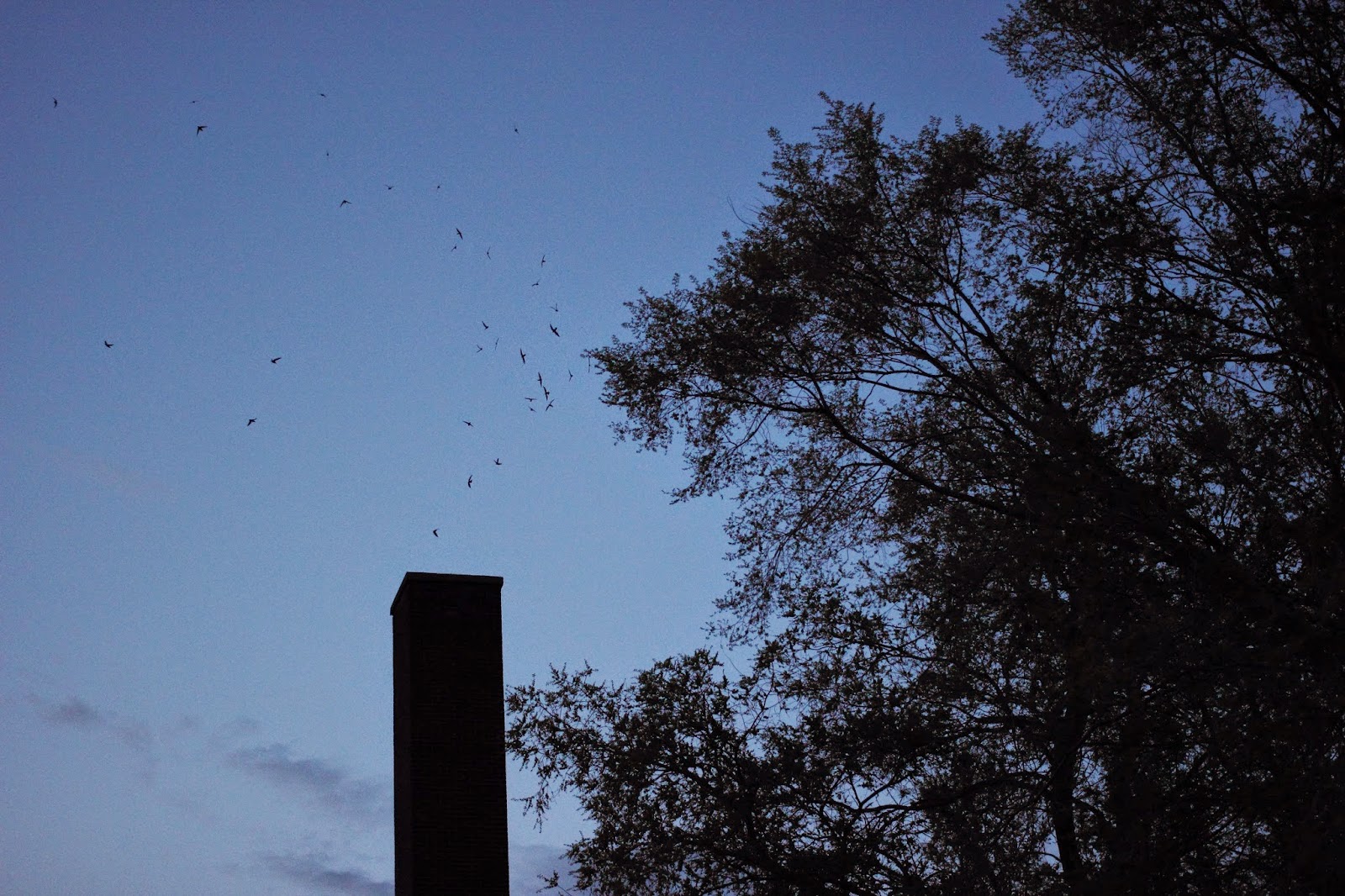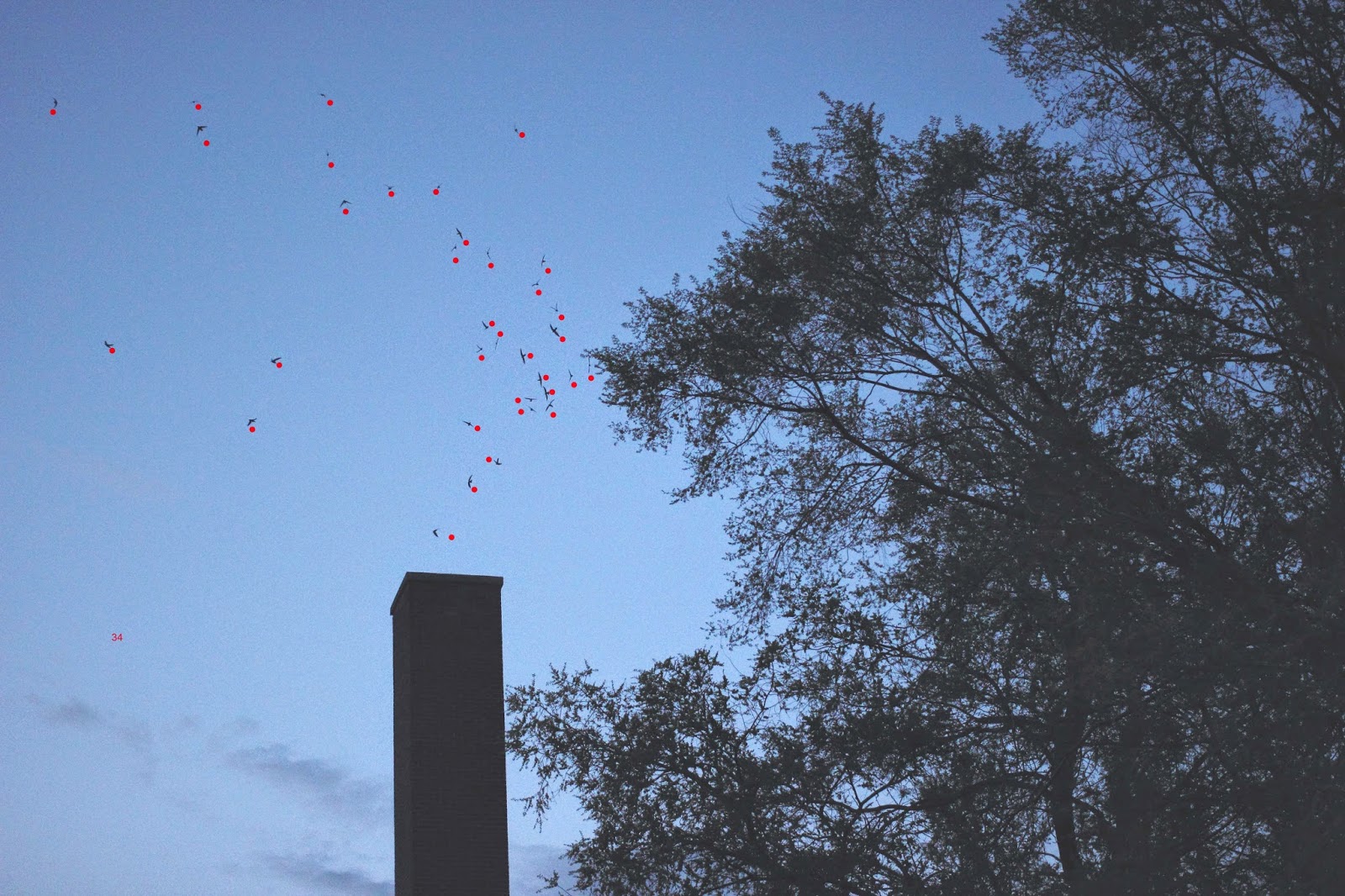News and posts
MCSI News Flash: wrapping up June and Canada Day beginnings
It’s A Wrap! MCSI Bulletin 4 for 2014
TRENDING: HOT, HOT, HOT & MOSQUITOES!
mbchimneyswift@gmail.com
Bulletin Number 2 for 2014
The second National Monitoring Night, Sunday May 25th, was a cool night again following another rainy day. Maybe we will get out of our long underwear and rain jackets before this Blitz is over. The up and not so down details of an “interesting” evening follow…
Ken and Jan in Dauphin had 48 swifts roosting and noted many entries after “the magic hour”. This was an increase from the 11 swifts seen on the first national monitoring night.
In St. Adolphe, the upward trend in numbers continued but mystery shrouded our evening. Rob had 1 +2 in at the SE + NE Club Amical chimneys respectively; I had 2 in at Main St.; Jacquie had 0 swifts at Brodeur Bros.; and Frank counted 2 in at the Church. Then “something” happened at the very end of the roosting hour. The Church swifts left after a mob of 8 chsw came screaming by.
About half way through the monitoring period, I saw a flock of what looked like 9 swifts over the Red River. Rob, who was a long block away, saw 8 swifts just at the end of the observation period, as they moved north past Brodeur Bros. and then to the Church. Rob came back to the Church wondering who got all the roosting birds. Nobody did. We had 10 airborne swifts and no idea of where they would overnight. Also, as we were debriefing during our “congregation” at the Church, a chsw dove into the Church chimney about 15 min. post-roosting hour and then left a short time later!
Ruby and her flock of monitors had 36 swifts roosting in the tall Selkirk chimney, up from 25 the first night. Also, there were 7 entries then 2 exits in the red chimney; 5 swifts were in the site at the end of the roosting hour which left two chimney swifts unaccounted for in a roost site.
Two issues seem certain. First, available nesting territory is not immediately claimed at the onset of the season. Perhaps the 2013 breeding pair at the St. Adolphe Church are dead or late-arriving and the 2014 migrants are trying to sort themselves out for the current nesting season.
Second, we have solid data that chimney swifts may be airborne well after the roosting hour. Therefore, in-site roosting totals may underestimate the total number of birds in the immediate area. Another challenge for the number crunchers…
Elsewhere in Manitoba, David Dawson counted 2 chimney swifts roosting at La Broquerie. Don and Roxie Reimer are still waiting for the first arrivals at the Steinbach hospital. David first discovered that this site was active during last year’s season, so we do not have historical information for the hospital chimney. There is hope though for migrants to appear this week or later in the season.
There can be new arrivals in St. Adolphe during the third week of June. These birds may be late arriving migrants from the south or re-dispersing local swifts that had arrived in May. The same thing may happen elsewhere in Manitoba. So even if sites are empty now, there is a possibility of occupation later. Any additional monitoring of “empty” sites during the third week of June would be appreciated!
Thursday, May 29th is the next target for the national blitz. I expect numbers to build in the roost sites in Selkirk and Dauphin. For other chimneys that may be nest sites, do not give up hope of seeing swifts if they have not been sighted to date. It has been a late spring and as we are at the northern periphery of the distribution range, migrants are still arriving.
The weather is improving to the point that bug smacking on the windshield is occurring at night now and those marvelous mosquitoes are starting to appear. Think of these insects as chimney swift food instead of pesky summer intruders!
I hope you all enjoy some bounty of birds on Thursday night. Another bulletin will be sent out to update you on the developments and trends. Your monitoring efforts are appreciated very much!
Cheers, Barb.
mbchimneyswift@gmail.com
News Bulletin 1 from the MCSI
 Manitoba News Bulletin for the National Monitoring Blitz Night No. 1 – May 21, 2014:
Manitoba News Bulletin for the National Monitoring Blitz Night No. 1 – May 21, 2014:
The early returns are in and there was a lot of empty air space on the chilly Wednesday evening. Matt Dedrick, who coordinates the Carman volunteers, wondered if a new subspecies was indicated: “Chaetura pelagica noseeum”! Many people would agree as no chimney swifts were seen at: two Carman sites; two Clearwater sites; Portage La Prairie; and La Broquerie.
For monitors lucky enough to spot swifts, few birds roosted for the night in the occupied chimneys. The Dauphin roost had 11 swifts and the record high count for the night was at Selkirk where 25 swifts came in.
In St. Adolphe, the five nest sites had varying activity. Empty sites = SE Club Amical and Brodeur Bros.; occupied sites = 2 swifts in at the NE Club Amical chimney; 2 swifts in Main St.; and only 1 at the Church.
All has changed now that the cold weather system has moved along and brought the first string of clear, warm days (ok, 30 C is just hot). the bug-inspiring heat has created favourable feeding conditions and chimney swifts have been sighted during the daytime now in various locations such as Fort Whyte Alive and East Kildonan in Winnipeg.
Roosting hour sightings have picked up also since Wed. Interestingly, 4 chimney swifts were active in the Carman Memorial Hall site (entries and exits) before 2 roosted for the night on Thursday, May 22nd. Roosting birds were noted again on Friday, May 23rd.
So the daytime sightings and entry/exit behavior indicate that migrants are moving into our area and nesting territory is being established for the season. The invisible swifts seem to have disappeared.
It seems that a global threat of thunderstorms is upon us all for Sunday night, May 25th, which is National Monitoring Blitz Night No. 2. From Dauphin to La Broquerie to Portage to Winnipeg, Environment Canada has the lightning icon embedded in its forecast.
Just a reminder to all monitors that safety comes first and if there is storm activity, we will pass on chimney side viewing. If light or intermittent rain occurs, monitoring can proceed…in fact, the chimney swifts in St. Adolphe have put on amazing feeding shows at the edge of storm fronts.
All the best for your viewing pleasure Sunday night and may the swifts be winging their way to a site near you…
(Our CHSW season started with an opportunity to watch a Kingston, ON roost site over the May long weekend. Thanks to Chris Grooms for steering us to the location and to Frank Machovec who has provided a link to some “phone video” footage Rob took of the 131 swift spectacle – amazing birds!). Click here to see the video.
Looking forward to hearing from you soon, Barb.
(mbchimneyswift@gmail.com)
They’re back!
Some Tools for the Coming Monitoring Season!
|
Let’s Watch Those Chimneys! The Chimney Swifts are working their way northward and should be visiting Manitoba soon. The Manitoba Chimney Swift Initiative has prepared survey forms and survey protocols to guide monitors in the 2014 season. A primary focus of our efforts for 2014 will be chimney observations as part of a national effort. Monitoring is to take place during the “roost hour” on May 21, May 25, May 29, and June 2. The national four-day monitoring protocol may be seen at http://www.mbchimneyswift.ca/Documents/MB_Protocol_Swift_2014_ROOST.pdf and the monitoring form may be obtained at http://www.mbchimneyswift.ca/Documents/MB_Survey%20data%20sheet_Swift_ROOST_2014.pdf For those monitoring their sites on other dates throughout the season, please use the “MCSI monitoring protocol.” The protocol is explained at http://www.mbchimneyswift.ca/Documents/Monitoring_Protocol.pdf , and the associated monitoring form is at http://www.mbchimneyswift.ca/Documents/report_form.pdf Check the resources area of our website at http://www.mbchimneyswift.ca/resources.html for a variety of information about monitoring. Please email the monitoring coordinator at mbchimneyswift@gmail.com to volunteer or ask any questions about the monitoring program for 2014. Now, don’t overstress those neck muscles! |
A New Season Begins (soon)!
—
c/o Nature Manitoba, #401 – 63 Albert Street, Winnipeg, MB R3B 1G4
Another one bites the dust!
Well another Chimney Swift season has come and gone, and we all need to find something else to do during the roost hour!
I would like to thank you all for taking the time to monitor your sites and report your observations. It took dedication– whether your sites were active or vacant and despite a variety of weather conditions.
Let’s not dwell on the lamentable conditions early in the season or swifts which didn’t respect the “roost hour” or “active” chimneys without swifts or sites far removed from Tim Hortons or promising sites spurned by our avian quarry…
2013 season highlights:
First swifts reported: May 12 (Saint Adolphe)
Last swifts reported: August 26 (Selkirk)
“New” active sites found in Winnipeg (two sites), Steinbach, Lac du Bonnet*, The Pas*
In Lac du Bonnet and The Pas there are reliable daytime reports of swifts and apparent nearby chimneys for roosting, but we don’t yet have documented entries into chimneys.
- 60 sites observed
- Sites monitored with NO swifts observed: 18
- Sites monitored with 1 to 4 swifts observed: 19
- Sites monitored with 5 or more swifts observed: 13
- 7 towers checked
As I’m sure you all recall, the season started with cool and rainy weather and the the later-than-usual return of swifts to many locations. Overall monitoring results were erratic with “normal” seasons in some locations and late-arriving or absent swifts at others. Dauphin saw a record peak number of swifts (121) at its roost site, making one wonder where the “extra” birds came from and where they ended up. The Selkirk roost had off-peak numbers at the main site and increased numbers at a nearby secondary site. The Carman main roost site saw lower than usual visitation, but a one-time spike in numbers at a secondary site.
A few monitoring reports noted that swifts arrived or departed outside the expected “roost hour window,” and this factor suggests that we may have missed a number of entries and exits at some sites. It is possible, then. that some sites may have erroneously been counted as vacant. Some other reports noted the proximity of many swifts that didn’t enter the expected chimney: this suggests the existence of sites that we have yet to identify.
We participated in a nationally planned four day monitoring project at selected sites. It turned out the designated dates were too early for many of our swifts, and some sites saw their first swifts on the last day of observation. The cool and wet weather didn’t help either…
As far as our artificial towers are concerned, the less said, the better. The five towers erected by the Chimney Swift Initiative remain vacant, as do two “artificial trees” in the La Broquerie area. To our consternation, towers in Minnesota do attract swifts.
Early in the year, two members of the steering committee for the project attended a Chimney Swift Workshop in Montreal. We made two presentations and met with representatives from various Canadian and American swift projects. Discussions revealed a number of common concerns, and the groundwork has been laid for coordinated monitoring and species recovery efforts.
For your viewing pleasure:
A summary of moniring results is posted on our website, and it outlines peak numbers of swifts seen at sites from 2007 to 2013. Cast your eyes to http://www.mbchimneyswift.ca/Documents/2013_sites.pdf
The summary of the four-day monitoring results may be seen at http://www.mbchimneyswift.ca/Documents/2013_four_days.pdf
I recently completed the final report in connection with funding received from the provincial Endangered Species and Biodiversity Fund. The narrative part of the report is available on our web site at
http://www.mbchimneyswift.ca/Documents/ESBF_2013.pdf
As you all know, the cluster of five swift sites in Saint Adolphe is a jewel in the crown for the Chimney Swift Initiative. The 2013 annaual summary of activity in Saint Adolphe may be viewed at
http://www.mbchimneyswift.ca/Documents/stadolphe_2013.pdf Special thanks go to the Stewarts for their monitoring and analytical efforts.
In closing, thanks again for your efforts in support of the project!
Frank Machovec












